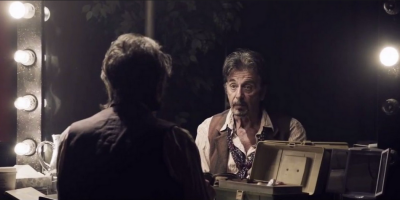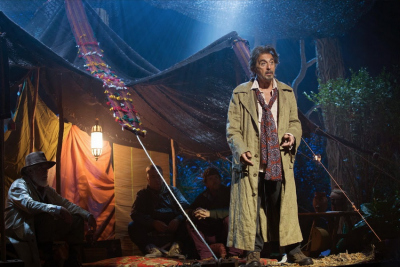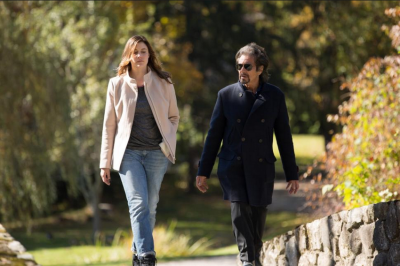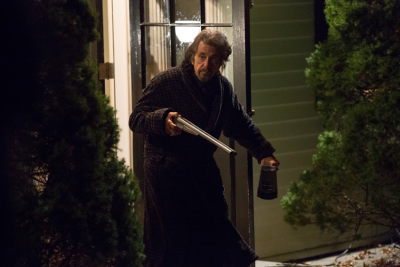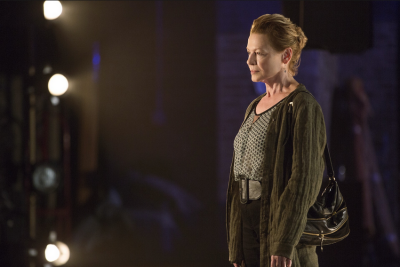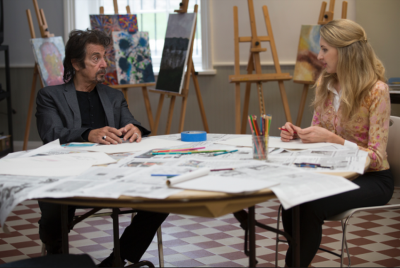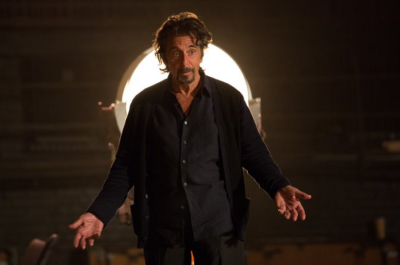Never would I have imagined someone could take the structural complexities of Philip Roth’s penultimate novel, and turn it into a film, let alone see a tour de force performance with the main character, Simon Axler, delivered by none other than Al Pacino. But, leave it to director Barry Levinson and screenwriters Buck Henry and Michael Zebede to do just that. In fact, so compelling was the 2009 novel that by the end of the year, Pacino himself had bought the film rights.
Once described by, I believe The New York Times, as the story of “…an aging stage actor whose empty life is altered by a ‘counterplot of unusual erotic desire'”, THE HUMBLING introduces us to Simon Axler. A once famed stage actor, Simon is just this side of a has been. As he sits in his dressing room for what may well be his final Broadway performance, panic takes over and Simon imagines himself being locked out of the theater and unable to go on-stage. As he is snapped out of this living nightmare by a knock on his dressing room door, he turns to his mirror, in conversation with himself through Shakespeare’s “all the world’s a stage” monologue, questioning reality, fantasy, perception and acceptance. It is a powerful opening that dazzles with contemplative metaphor thanks to Pacino’s performance, Levinson’s direction and flawless cinematography of Adam Jandrup; while also preparing us for a shock as once on stage, to the horror of the audience (albeit getting their waning attention) and ours, Simon takes a swan dive off the stage into the orchestra pit.
Placed into a psychiatric hospital for his obvious depression, as Simon, Al Pacino mesmerizes with protracted, soulful and searching monologues (shot in single unbroken takes, mind you) that take us through Simon’s life, his pain, his fall into nothingness, how he’s “lost track of his craft”. It is a soliloquy in which the line blurs between reality and fantasy? Is Simon performing to the therapy group? Is this Simon Axler’s confession or Al Pacino’s? Pacino just reels you into the proceedings.
Characters come and go in Simon’s life, just as they enter and exit a stage. A romantic entanglement with Pegeen, the now grown-up lesbian daughter of his once best friends, gives Simon the appearance of coming back from the dead, but on closer inspection serves to show the desperation of a lonely man and further blur and obscure the line between fantasy and reality. Dark comedic moments are fueled by Sybil, one of his fellow patients at the hospital, who now sees Simon as her best friend and seeks him out to murder her husband, believing Simon to be the man for the job because he handled a gun as an actor. Some laugh-out-loud comedic moments contrast the film’s “tragedy” thanks to little touches like an injured Simon asking a nurse if she believed his moan of pain. Unfortunately, some ill-utilized non sequitur additions of Pegeen’s former lesbian lover now transgender male pursuer unnecessarily convolute the narrative . And through it all, Simon engages with running narrative monologues with his therapist via Skype.
But where THE HUMBLING takes flight and finds its full voice is in the final act, perhaps the final act of Simon’s life, as he comes face to face with his demons and himself.
Having read Roth’s novel on its release, I am enthralled by the Henry-Zebede script adaptation, Levinson’s direction and Pacino’s interpretation of Simon Axler. With the intimacy of a theatre piece, Levinson and company play with the idea of art imitating life imitating art. Always bordering on the edge of fantasy and reality, insanity and sanity, THE HUMBLING is contemplative and reflective; particularly for anyone who survives on their creativity, on their skill set that is not “adaptable” to something else. But a caveat, as with the Roth novel, the film may also be difficult for many to grasp because of their own limitations of a life lived.
Standout with the script adaptation are Simon’s internal monologues with self which are brought to life on film through Simon’s Skypes with his therapist as well as dream/hallucination visual montage. The introspection truly gives the film a tour de force monologue styling with which Pacino just soars. (And dare we even mention how divinely Pacino interprets the Shakespearean passages?) The third act of the film explodes with life and contrasting metaphor, notably in a screaming match between Simon and Pegeen that gives the film so much energy, we are buoyed all the way to the final shot.
THE HUMBLING is at its best when Pacino is on screen. The monologues and soliloquies are powerful, stirring, mesmerizing. You know you are watching greatness. In these moments, Pacino delivers a master class in acting. Sadly, the film loses momentum and gravitas with the cavalcade of characters who entreat themselves into Simon’s life and garner too much screen time; Kyra Sedgwick as the Dean of the local college where Pegeen is employed perhaps being the worst, both in wasting Sedgwick’s talent and wasting screen time with repeated psycho babble calls to Simon in an attempt to win back the affection of Pegeen. Billy Porter’s turn as the gender reassigned former lover of Pegeen (seems there is no one of either sex that Pegeen has not slept with) is stilted, uncomfortable and detracts from the focus of Simon Axler, not to mention being inconclusive with character resolution.
Supporting cast are all wonderful. As Simon’s faithful and long-suffering agent, Jerry, Charles Grodin is an upbeat, albeit sardonic, force within the film and Simon Axler’s world. (But I have to ask – when did Charles Grodin start to look so aged? I always think of him as a youthful cynical “Murray Bloom”, the accountant alongside Kevin Kline in “Dave”.) As Pegeen’s mother Carol, Dianne Wiest does angst like nobody’s business and is, as always, a battling maternal force, while as father Asa, Dan Hedaya serves as a wonderfully more softly aggrieved father.
A real treat, however, is Greta Gerwig who, as Pegeen, is more than a surprise with many of the introspective and intense scenes between Pegeen and Simon. We are all well familiar with Gerwig’s quirky, mumblecore, flightier, eccentric, casual characters, but here, she spreads her wings with some depth and intensity not normally achieved in her work. Refreshing to see. And it’s thanks to her skill and that of Pacino that the age differential of this May-December relationship/romance becomes a non-issue.
But perhaps the real gift of THE HUMBLING, beyond Al Pacino, is Nina Arianda. An absolute hoot, her chemistry with Pacino is dynamic. Running the gamut of emotion, Pacino and Arianda just feed off each other. Both are physically expressive, particularly through their eyes and have the innate ability to elicit reactions of surprise from the other that elevate the characters while resonating with believability. Having seen Arianda in “Rob the Mob”, “The Disappearance of Eleanor Rigby/Him/Her” and now THE HUMBLING, among others, she is chameleonic to the point of often being physically and emotionally unrecognizable, thus making each character unique and distinct. And she does it again here as Sybil.
Shot in Connecticut over some 20-days actually “in and around” director Barry Levinson’s own home, the visual design is contained and controlled, much like that of a stage performance. Capturing a beautiful change of seasons to serve as a passage of time, cinematographer Adam Jandrup proves to be a consummate visual storyteller with light and lens. Shot digitally, there is a razor honed crisp polish that bodes well for the film and the story. Jandrup’s lensing magic starts with the opening backstage sequences as Simon goes through his monologue and “conversation” with himself in the dressing table mirror. With the character only made up thus far in half face, lensing captures two distinct sides of the face, then expertly cut by editor Aaron Yanes, in effect mirrors the masks of comedy and tragedy. A dazzling introduction to the film and the character of Simon Axler.
Camera angles, framing, dutching, and the ever present use of mirrors and windows are magnificent throughout and imbue the audience with the dizzying effect of not being in control of one’s life anymore, of grasping at straws, settling for something. Extremely metaphoric and visually telling. The finale scene alone, with stark, harsh lighting, extreme close-ups and skewed POV just pulsates with tension and above all, life. Nice symbolism is further found within Sam Lisenco’s beautifully apportioned production design, most notably with a Lionel-type train set that runs throughout Axler’s house thanks to the introduction of Pegeen, having no beginning and no end, just a continual track mounting the hills and valleys of life.
THE HUMBLING. An examination of a man’s life that is built upon contrast and conflict, certainty and uncertainty, reality and fantasy with an ever-questioning self introspection. A film filled with life as a man nears the end of his, indelibly given life by Al Pacino.
Directed by Barry Levinson
Written by Buck Henry and Michael Zebede
Cast: Al Pacino, Greta Gerwig, Nina Arianda, Charles Grodin, Dianne Wiest, Dan Hedaya, Kyra Sedgwick

